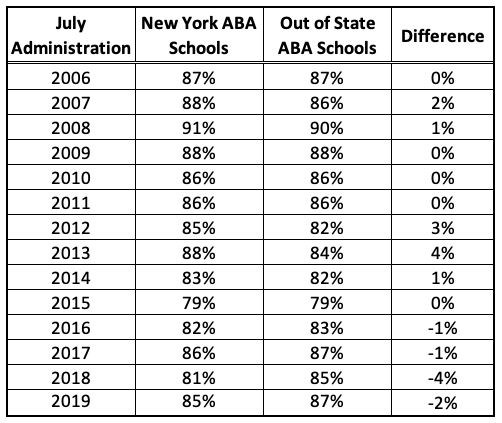Comparing In-state and Out-of-State Examinee Performance on the New York Bar Exam
- Tommy Sangchompuphen

- Oct 23, 2019
- 3 min read
The New York bar exam results came out today. Congratulations to everyone who passed—all 6,536 of you!
The overall pass rate on the July 2019 New York bar exam was 65%, which is 2% higher than last year’s overall passage rate of 63%.
However, when you examine only first-time examinees from American Bar Association-accredited law schools, the passage rate significantly jumps to 86%, an increase of 3% from the July 2018 examination. The passing rate for graduates of New York law schools who took the bar examination in July 2019 for the first time is 85%, which is an increase of 4% from last year.
You might want to read that again. Examinees who attended law school outside of New York actually fared better on the New York bar exam than those who attended law school in New York. That wasn’t always the case.
So I was wondering: Did New York’s adoption of the Uniform Bar Exam create a leveling playing field whereby attending a New York law school now provides no additional benefit to passing the New York bar exam?
Let’s first look at the Uniform Bar Exam. The UBE is coordinated by National Conference of Bar Examiners and is composed of the Multistate Essay Examination (MEE), two Multistate Performance Test (MPT) tasks, and the Multistate Bar Examination (MBE)—the 200-question multiple-choice test. The UBE is uniformly administered, graded, and scored and results in a portable score that can be transferred to other UBE jurisdictions. No state-specific law is tested on the UBE, and examinees need only know generally applicable principles of law. New York first administered the UBE in July 2016.
I compared the first-time passage rates for ABA-accredited New York schools and out-of-state schools for the 10 different July administrations before New York’s first administration of the UBE (July 2006 to July 2015) against the first-time passage rates for these same schools for the four UBE administrations since July 2016 (July 2016 to July 2019).

What I discovered is that on the July administrations before the administration of the UBE, first-time examinees from ABA-accredited law schools in New York performed as well or better than their out-of-state counterparts.
Over this 10-year period, first-time New York examinees from ABA-accredited schools, on average, passed the New York bar at a rate 1.10 percentage points higher than out-of-state examinees. In some administrations, New York examinees’ pass rates were 3 and 4 percentage points higher than out-of-state examinees (in July 2012 and July 2013, respectively).
Compare that to the pass rates when New York administered the UBE. Since the first administration of the UBE, out-of-state examinees from ABA-accredited schools outperformed the in-state examinees on each and every administration.
The out-of-state examinees had a higher first-time passage rate on the first UBE administration in July 2016 (83% for out-of-state examinees versus 82% for in-state examinees); in July 2017 (87% versus 86%); in July 2018 (85% versus 81%); and on the most recent administration in July 2019 (87% versus 85%). So while first-time New York examinees outperformed out-of-state examinees by an average of 1.10 percentage points on the 10 pre-UBE July administrations, out-of-state examinees flipped this statistic with the administration of the UBE and have outperformed in-state examinees by an average of 2.00 percentage points.

What does this tell me? Since the UBE no longer tests state-specific law—which means examinees don’t have to know New York law to pass the two-day bar exam—attending a New York law school doesn’t necessarily provide examinees with an advantage on the New York bar exam (which is now the UBE).









